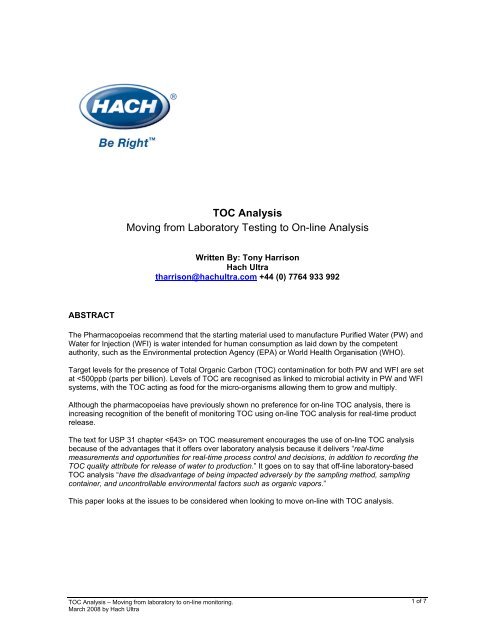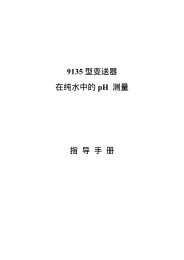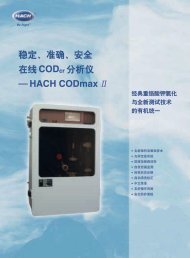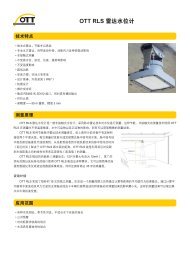TOC Analysis Moving from Laboratory Testing to On-line Analysis
TOC Analysis Moving from Laboratory Testing to On-line Analysis
TOC Analysis Moving from Laboratory Testing to On-line Analysis
You also want an ePaper? Increase the reach of your titles
YUMPU automatically turns print PDFs into web optimized ePapers that Google loves.
ABSTRACT<br />
<strong>TOC</strong> <strong>Analysis</strong><br />
<strong>Moving</strong> <strong>from</strong> <strong>Labora<strong>to</strong>ry</strong> <strong>Testing</strong> <strong>to</strong> <strong>On</strong>-<strong>line</strong> <strong>Analysis</strong><br />
<strong>TOC</strong> <strong>Analysis</strong> – <strong>Moving</strong> <strong>from</strong> labora<strong>to</strong>ry <strong>to</strong> on-<strong>line</strong> moni<strong>to</strong>ring.<br />
March 2008 by Hach Ultra<br />
Written By: Tony Harrison<br />
Hach Ultra<br />
tharrison@hachultra.com +44 (0) 7764 933 992<br />
The Pharmacopoeias recommend that the starting material used <strong>to</strong> manufacture Purified Water (PW) and<br />
Water for Injection (WFI) is water intended for human consumption as laid down by the competent<br />
authority, such as the Environmental protection Agency (EPA) or World Health Organisation (WHO).<br />
Target levels for the presence of Total Organic Carbon (<strong>TOC</strong>) contamination for both PW and WFI are set<br />
at
LABORATORY WIDE-RANGING MEMBRANE CONDUCTIVITY <strong>TOC</strong> ANALYSERS<br />
<strong>Labora<strong>to</strong>ry</strong>-based <strong>TOC</strong> analysers utilise membrane conductivity (MC) with a CO2 permeable membrane<br />
and two conductivity cells <strong>to</strong> measure conductivity before and after oxidation of the organic material.<br />
Typically, the <strong>TOC</strong> analyser will have up <strong>to</strong> three conductivity probes; one for reporting conductivity and<br />
two <strong>to</strong> make the before- and after-oxidation measurements.<br />
MC technology was developed <strong>to</strong> provide a lab-based general purpose <strong>TOC</strong> analyser capable of<br />
measuring <strong>TOC</strong> in a wide range of water types. Interference <strong>from</strong> other salts and chemicals present in<br />
non-GMP waters is avoided as they cannot pass through the membrane, allowing the MC analyser <strong>to</strong> only<br />
report increases in conductivity <strong>from</strong> the evolved CO2 <strong>from</strong> the oxidised <strong>TOC</strong>. However, they are a flowthrough<br />
design and full oxidation the <strong>TOC</strong> is rarely achieved. Instead fac<strong>to</strong>rs are used <strong>to</strong> extrapolate the<br />
<strong>TOC</strong> <strong>from</strong> the slight changes in conductivity as the <strong>TOC</strong> is partially oxidised on it’s way through the<br />
analyser.<br />
This technology does not have a stable calibration and, if used for on-<strong>line</strong> analysis, is affected by<br />
temperature, pressure and flow rate changes in the PW or WFI system. Also, the CO2 transfer rate<br />
through the membrane is dependant on the pH and temperature of the water system. Slight drift in the<br />
calibration of the multiple conductivity cells used can also contribute <strong>to</strong> inaccurate <strong>TOC</strong> analysis. In fact,<br />
when this technology is used in the labora<strong>to</strong>ry, a calibration check is frequently recommended for each<br />
batch of <strong>TOC</strong> samples run <strong>to</strong> ensure that the analyser calibration has not drifted.<br />
<strong>TOC</strong> <strong>Analysis</strong> – <strong>Moving</strong> <strong>from</strong> labora<strong>to</strong>ry <strong>to</strong> on-<strong>line</strong> moni<strong>to</strong>ring.<br />
March 2008 by Hach Ultra<br />
Figure 1: Lab-based Membrane Conductivity <strong>TOC</strong> <strong>Analysis</strong><br />
ON-LINE DIRECT CONDUCTOMETRIC-BASED <strong>TOC</strong> ANALYSERS<br />
Direct Conduc<strong>to</strong>metric (DC) based <strong>TOC</strong> analysers, such as the Anatel PAT700, utilise a single<br />
conductivity meter <strong>to</strong> measure the increased conductivity of a water aliquot after all the organic material in<br />
the aliquot has been completely oxidised <strong>to</strong> carbon dioxide (CO2) using ultra-violet light.<br />
Because the water treatment system creating PW and WFI is designed <strong>to</strong> GMP-compliant quality water,<br />
there must be no potentially interfering contaminants present, so the membrane technology is not an<br />
advantage and, being much more stable and robust in design than membrane flow-through <strong>TOC</strong><br />
analysers, these DC <strong>TOC</strong> analysers are not affected by the temperature, pressure and flow changes<br />
expected on a typical PW or WFI system.<br />
As shown in Figure 2 below, the WFI or PW aliquot is trapped in the analysis cell by valves, the oxidising<br />
UV lamp is turned on and the organic materials are fully oxidised. The difference in conductivity created by<br />
2 of 7
the CO2 evolved through the oxidisation process is directly proportional <strong>to</strong> the amount of <strong>TOC</strong> present in<br />
the aliquot. The analysis cycle typically takes around 3 minutes on PW and WFI, allowing the DC <strong>TOC</strong><br />
analyser <strong>to</strong> report <strong>TOC</strong> levels every 3 minutes.<br />
<strong>TOC</strong> <strong>Analysis</strong> – <strong>Moving</strong> <strong>from</strong> labora<strong>to</strong>ry <strong>to</strong> on-<strong>line</strong> moni<strong>to</strong>ring.<br />
March 2008 by Hach Ultra<br />
Figure 2: <strong>On</strong>-<strong>line</strong> Direct Conduc<strong>to</strong>metric <strong>TOC</strong> <strong>Analysis</strong><br />
DC <strong>TOC</strong> analyzers are based on the assumption that the only conductive species generated during UV<br />
oxidation is CO2. The amount of CO2 measured is directly proportional <strong>to</strong> <strong>TOC</strong> in the water sample.<br />
MONITORING THE UV LAMP<br />
Both labora<strong>to</strong>ry and on-<strong>line</strong> <strong>TOC</strong> analysers for pharmaceutical-grade waters utilise ultra-violet light <strong>to</strong><br />
oxidise the organic material in the water <strong>to</strong> CO2. As the UV lamp ages it produces less UV light and it is<br />
not as effective at oxidising the organic material. With on-<strong>line</strong> direct conduc<strong>to</strong>metric <strong>TOC</strong> analysers, it is<br />
important that the oxidation time is varied <strong>to</strong> ensure complete oxidation.<br />
However, it is possible that all <strong>TOC</strong> analysers will report very low (typically
combined with a ‘main’ and ‘standby’ UV lamp arrangement, so that on detecting the ‘main’ UV lamp<br />
failure, the analyser can au<strong>to</strong>matically switch <strong>to</strong> the ‘standby’ UV lamp and continue <strong>to</strong> moni<strong>to</strong>r on-<strong>line</strong><br />
<strong>TOC</strong> whilst raising an alarm so that the maintenance team can replace the failed UV lamp in a timely<br />
manner.<br />
VERIFYING ON-LINE <strong>TOC</strong> ANALYSERS<br />
Unlike the membrane-based analysers used for labora<strong>to</strong>ry <strong>TOC</strong> analysis the on-<strong>line</strong> <strong>TOC</strong> analyser must<br />
be robust, have a stable calibration and be capable of consistent, repeatable analysis under varying<br />
sample temperatures, pressure and flow-rates.<br />
Figure 4: <strong>TOC</strong> analysers use temperature-compensated conductivity measurement<br />
<strong>TOC</strong> analysers are basically temperature-compensated differential conductivity instruments using UV light<br />
<strong>to</strong> oxidise the organic material <strong>to</strong> CO2 and utilising before-and-after-conductivity measurements as a<br />
surrogate measurement for <strong>TOC</strong>. They must be able <strong>to</strong> accurately moni<strong>to</strong>r the temperature of the sample<br />
as it is analysed <strong>to</strong> ensure that the final conductivity measurement is compensated for temperature<br />
change, otherwise the small change in conductivity caused by the CO2 evolved <strong>from</strong> the oxidised <strong>TOC</strong> will<br />
be swamped by the change in conductivity due <strong>to</strong> the temperature change in the sample.<br />
Hence it is important <strong>to</strong> verify:<br />
a) the calibration of conductivity meter used <strong>to</strong> measure <strong>TOC</strong><br />
b) the calibration of the temperature compensation sensor<br />
c) the <strong>TOC</strong> meter calibration against USP-traceable <strong>TOC</strong> standards<br />
d) system suitability<br />
e) the UV lamps<br />
a) Verifying the calibration of the conductivity meter used <strong>to</strong> measure <strong>TOC</strong><br />
Guidance was given in USP30 regarding the calibration verification conductivity meters. This<br />
was split in<strong>to</strong> two parts: meter calibration and cell constant. Hach Ultra provides an SOP for carrying<br />
these tests out on the Anatel PAT700 <strong>TOC</strong> analyser: SOP 700-4.<br />
Meter calibration verification is made by disconnecting the measurement cell and replacing it with a<br />
known-value NIST-traceable resis<strong>to</strong>r. Cell constant is verified by running a certified conductivity<br />
sample through the measurement cell.<br />
<strong>TOC</strong> <strong>Analysis</strong> – <strong>Moving</strong> <strong>from</strong> labora<strong>to</strong>ry <strong>to</strong> on-<strong>line</strong> moni<strong>to</strong>ring.<br />
March 2008 by Hach Ultra<br />
4 of 7
Figure 5: Verifying calibration of <strong>TOC</strong> conductivity meter using NIST-traceable resis<strong>to</strong>r<br />
Figure 6: Verifying calibration of <strong>TOC</strong> conductivity cell using certified conductivity standard<br />
b) Verifying the calibration of the temperature compensation sensor<br />
The <strong>TOC</strong> analyser is a temperature compensated differential conductivity meter, so it is critical <strong>to</strong><br />
verify the accuracy of the temperature sensor used in the <strong>TOC</strong> measurement. Hach Ultra provides an<br />
SOP for carrying this test out on the Anatel PAT700 <strong>TOC</strong> analyser: SOP 643-4.<br />
This verification is done by connecting a NIST- traceable calibrated external temperature instrument <strong>to</strong><br />
the water sample inlet of the <strong>TOC</strong> analyser and comparing the temperature reading on the external<br />
instrument <strong>to</strong> that of the <strong>TOC</strong> analyser internal temperature sensor.<br />
Figure 7: Verifying calibration of <strong>TOC</strong> analysis temperature compensation sensor using external instrument<br />
<strong>TOC</strong> <strong>Analysis</strong> – <strong>Moving</strong> <strong>from</strong> labora<strong>to</strong>ry <strong>to</strong> on-<strong>line</strong> moni<strong>to</strong>ring.<br />
March 2008 by Hach Ultra<br />
5 of 7
c) Verifying the <strong>TOC</strong> calibration against USP-traceable <strong>TOC</strong> standards<br />
The GMP-critical on-<strong>line</strong> <strong>TOC</strong> analyser is used <strong>to</strong> demonstrate that the <strong>TOC</strong> level in the PW or WFI<br />
water system is 85%
e) Verifying the UV lamp<br />
Correct operation of the UV lamp is fundamental <strong>to</strong> the <strong>TOC</strong> analysis. Robust on-<strong>line</strong> <strong>TOC</strong> analysers<br />
will measure the UV lamp output and have main and stand-by UV lamps <strong>to</strong> ensure 100% up-time<br />
should one of the UV lamps fail. When UV lamps age, their UV output falls and <strong>TOC</strong> oxidation times<br />
are extended. The on-<strong>line</strong> <strong>TOC</strong> analyser must be designed <strong>to</strong> moni<strong>to</strong>r the oxidation process and<br />
adjust it’s oxidation cycle time <strong>to</strong> allow for varying amounts of <strong>TOC</strong> and ageing UV lamps, otherwise<br />
the <strong>TOC</strong> analyser will report incorrect <strong>TOC</strong> levels.<br />
Either using an external UV meter, or using the analyser’s built-in diagnostics, verify that the main and<br />
standby UV lamps are working correctly.<br />
CONCLUSION<br />
<strong>TOC</strong> <strong>Analysis</strong> – <strong>Moving</strong> <strong>from</strong> labora<strong>to</strong>ry <strong>to</strong> on-<strong>line</strong> moni<strong>to</strong>ring.<br />
March 2008 by Hach Ultra<br />
Figure 10: Verify the Main and Standby UV lamps are working correctly<br />
When moving <strong>from</strong> labora<strong>to</strong>ry-based <strong>TOC</strong> analysis <strong>to</strong> on-<strong>line</strong> <strong>TOC</strong> analysis, it is important <strong>to</strong> consider the<br />
type of <strong>TOC</strong> analyser <strong>to</strong> be used. The complex design used in the wide-ranging membrane conductivity<br />
lab-based <strong>TOC</strong> analyser is not suitable for un-manned, on-<strong>line</strong> <strong>TOC</strong> analysis for the following reasons:<br />
<strong>Labora<strong>to</strong>ry</strong> membrane-based <strong>TOC</strong> analysers:<br />
• Calibration is not stable and frequent re-calibration is required<br />
• Not possible <strong>to</strong> verify the calibration of the conductivity cells used <strong>to</strong> measure <strong>TOC</strong><br />
• Not possible <strong>to</strong> verify or validate the calibration of the temperature compensation sensors<br />
• <strong>TOC</strong> result affected by flow rate changes caused by pressure fluctuations in PW or WFI system<br />
• <strong>TOC</strong> result dependant on UV lamp age, i.e. it is a flow-through design and the water is exposed <strong>to</strong><br />
the oxidising UV lamp for a fixed period, so, as the lamp intensity decreases with age, the <strong>TOC</strong><br />
analyser will tend <strong>to</strong> under-report the <strong>TOC</strong> present in the water<br />
Direct Conduc<strong>to</strong>metric <strong>TOC</strong> analysers are stable and robust and the Anatel PAT700 is specifically<br />
designed <strong>to</strong> support compliance and allows verification and calibration <strong>to</strong> all the pharmacopoeial<br />
requirements:<br />
Direct Conduc<strong>to</strong>metric on-<strong>line</strong> <strong>TOC</strong> analysers:<br />
• Calibration is stable and supports 6-monthly re-calibration intervals<br />
• The calibration of the conductivity cell used <strong>to</strong> measure <strong>TOC</strong> can be verified<br />
• The calibration of the temperature compensation sensor can be verified<br />
• <strong>TOC</strong> result is not affected by flow rate changes caused by pressure fluctuations in PW or WFI<br />
system (the Anatel takes a sample aliquot and fully oxidises the <strong>TOC</strong> content)<br />
• <strong>TOC</strong> result is not dependant on the level of the UV lamp output, i.e. the water sample aliquot<br />
exposure <strong>to</strong> the oxidising UV lamp is extended until all the <strong>TOC</strong> is fully oxidised. So, despite the<br />
lamp intensity decreasing with age, the <strong>TOC</strong> analyser will always report the correct <strong>TOC</strong> present<br />
in the water<br />
• UV lamp moni<strong>to</strong>ring and ‘main’ and ‘standby’ UV lamps <strong>to</strong> ensure that lamp failure is detected and<br />
that the analyser provides 100% up-time using the ‘standby’ UV lamp whilst the maintenance<br />
teams arrange the failed lamp replacement.<br />
7 of 7






